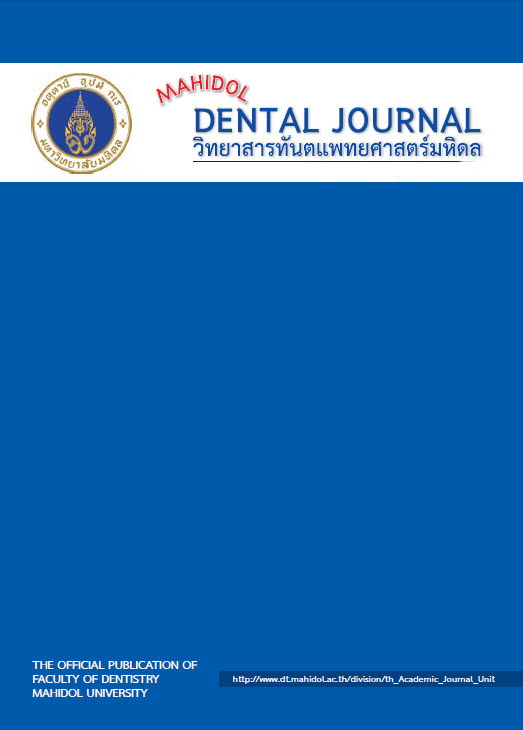Effect of ethanol wet bonding technique on bonding performance of dual-cured adhesive to root canal dentin
Main Article Content
Abstract
Objective: to evaluate the effect of modified smear layer using EDTA, NaOCl solutions with and without agitating application to solution on the bond strength of all-in-one adhesives to dentin.
Methods: One hundred and two non-carious third molar were cut perpendicular to the long axis at 2 mm. above CEJ. The standardized smear layer on dentin surface was created by polishing with 600-grit carbide paper. Then, all specimens were randomly divided to 6 groups: 1) Distilled water, 2) Distilled water with agitation, 3) 17% EDTA, 4) 17% EDTA with agitation, 5) 1% NaOCl, and 6) 1% NaOCl with agitation. 1 ml of each solution was applied on the dentin surface for 60 s. Smear layer characteristic was observed under SEM. Three all-in-one adhesives (SE-ONE;SE, G-ænial bond;GB, Optibond all-in-one;OP) were applied following the instructions. All specimens were restored with resin composite (Z250XT). The micro-tensile bond strength test and failure mode analysis were investigated.
Results: Modified smear layer using both solutions significantly increased the bond strength in some all-in-one adhesives (SE ,OP) with p < 0.05. Agitation application could produce significantly higher bond strength in GB and SE (p < 0.05). The clean dentin surface with some erosion and opening of dentinal tubules was found when modified with EDTA. While, NaOCl exhibited the reduction in smear layer thickness with dense and pack characteristic.
Conclusion: Modified smear layer with EDTA and NaOCl could gain the bond strength of some all-in-one adhesives (SE,OP). The agitation application to pretreated solutions improved the bonding performance of some all-in-one adhesives (SE, GB)
Article Details
References
2. Belli R, Sartori N, Peruchi LD, et al. Effect of multiple coats of ultra-mild all-in-one adhesives on bond strength to dentin covered with two different smear layer thicknesses. J Adhes Dent 2011; 13: 507-16.
3. Mine A, De Munck J, Cardoso MV, et al. Dentin-smear remains at self-etch adhesive interface. Dent Mater J. 2014; 30: 1147-53.
4. Suyama Y, Luhrs AK, De Munck J, et al. Potential smear layer interference with bonding of self-etching adhesives to dentin. J Adhes Dent 2013; 15: 317-24.
5. Torii Y, Hikasa R, Iwate S, Oyama F, Itou K and Yoshiyama M. Effect of EDTA conditioning on bond strength to bovine dentin promoted by four current adhesives. Am J Dent 2003; 16: 395-400.
6. Nikaido T, Takano Y, Sasafuchi Y, Burrow MF, Tagami J. (1999). Bond strengths to endodontically-treated teeth. American journal of dentistry, 12(4), 177-180.
7. Thanatvarakorn O, Nakajima M, Prasansuttiporn T, Ichinose S, Foxton RM and Tagami J. Effect of smear layer deproteinizing on resin-dentine interface with self-etch adhesive. J Dent 2014; 42: 298-304.
8. Kasraei S, Azarsina M and Khamverdi Z. Effect of Ethylene diamine tetra acetic acid and sodium hypochlorite solution conditioning on microtensile bond strength of one-step self-etch adhesives. J Conserv Dent 2013; 16: 243-6.
9. Kunawarote S, Nakajima M, Foxton RM and Tagami J. Effect of pretreatment with mildly acidic hypochlorous acid on adhesion to caries-affected dentin using a self-etch adhesive. Eur J Oral Sci 2011; 119: 86-92.
10. Chaves P, Giannini M and Ambrosano GM. Influence of smear layer pretreatments on bond strength to dentin. J Adhes Dent 2002; 4: 191-6.
11. Toledano M, Osorio R, Perdigao J, Rosales JI, Thompson JY and Cabrerizo-Vilchez MA. Effect of acid etching and collagen removal on dentin wettability and roughness. J Biomed Mater Res 1999; 47: 198-203.
12. Lai SC, Mak YF, Cheung GS, et al. Reversal of compromised bonding to oxidized etched dentin. J Dent Res 2001; 80: 1919-24.
13. Kunawarote S, Nakajima M, Shida K, Kitasako Y, Foxton RM and Tagami J. Effect of dentin pretreatment with mild acidic HOCl solution on microtensile bond strength and surface pH. J Dent 2010; 38: 261-8.
14. Zhou L, Wang Y, Yang H, Guo J, Tay FR and Huang C. Effect of chemical interaction on the bonding strengths of self-etching adhesives to deproteinised dentine. J Dent 2015; 43: 973-80.
15. Ermis RB, De Munck J, Cardoso MV, et al. Bond strength of self-etch adhesives to dentin prepared with three different diamond burs. Dent Mater 2008; 24: 978-85.
16. Cardoso MV, Coutinho E, Ermis RB, et al. Influence of dentin cavity surface finishing on micro-tensile bond strength of adhesives. Dent Mater 2008; 24: 492-501.
17. Kenshima S, Francci C, Reis A, Loguercio AD and Filho LE. Conditioning effect on dentin, resin tags and hybrid layer of different acidity self-etch adhesives applied to thick and thin smear layer. J Dent. 2006; 34: 775-83.
18. Thanatvarakorn O, Prasansuttiporn T, Takahashi M, et al. Effect of Scrubbing Technique with Mild Self-etching Adhesives on Dentin Bond Strengths and Nanoleakage Expression. J Adhes Dent 2016; 18: 197-204.
19. Senawongse P, Srihanon A, Muangmingsuk A and Harnirattisai C. Effect of dentine smear layer on the performance of self-etching adhesive systems: A micro-tensile bond strength study. J Biomed Mater Res B Appl Biomater 2010; 94: 212-21.
20. Loguercio AD, Stanislawczuk R, Mena-Serrano A and Reis A. Effect of 3-year water storage on the performance of one-step self-etch adhesives applied actively on dentine. J Dent 2011; 39: 578-87.
21. Yoshida Y, Nagakane K, Fukuda R, et al. Comparative study on adhesive performance of functional monomers. J Dent Res. 2004; 83: 454-8.
22. Rubens Nazareno Garcia et al. Bonding performance of a self-adhering flowable composite to substrates used in direct technque. RSBO 2013;10: 343-349


